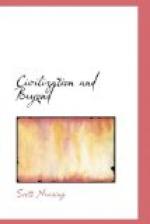Conservatives try to preserve both the structure and the traditional activities of a community on the plea that a bird in the hand is worth two in the bush. Liberals (moderates) would preserve the structure but bring its activities up to date. Radicals would scrap the old and replace it with a new structure and new activities geared to the new possibilities and the new requirements.
Survival wars from 1914 to 1945 marked not only the end of Britain’s planetary domination but the termination of Europe’s planetary regency. The events of the period also loosened the bonds that had held western civilization together.
A social structure which includes imperial nuclei and colonial dependencies is constantly threatened by colonial unrest and revolt. Colonial revolt, endemic in every civilization, became epidemic after 1943. The path to independence had been blazed by North and South American colonials. It was followed after 1943 by the inhabitants of British, French, Dutch, Spanish and Portuguese colonies in Asia and Africa. The slogan of the independence movement was “self-determination.”
Before self-determination can operate there must be a “self” capable of making decisions and carrying them into practice. Identification of the “self,” or “nationhood” as it was called in this era, involved bitter domestic struggle, internal reorganization and consolidation. The process was typified in the British Colonies of North America between 1770 and 1789 which produced the United States of North America. Asians and Africans who gained their independence after 1945 faced a double problem: the establishment of nationhood, and regional consolidation.
The British colonies in North America won their independence as a loose confederation of sovereign states. After war’s-end in 1783, they were able to form a regional federation: the United States of North America. Despite their efforts, they were unable to include Canada, which was under strong French influence. British colonials in Asia and Africa after 1943 were less fortunate. After winning their independence as Indians or Burmese, they were unable to take the next step and organize a United States of Southern Asia.
The Bandung Conference (in 1955) of representatives from Asia and African countries failed to realize the hopes of its conveners. After prolonged deliberations it was able to go no further than the “five principles” of self-determination and co-existence, under which the independence of each participating nation was reaffirmed and each agreed not to interfere in the internal affairs of its neighbors. The conference adjourned without establishing any form of organization or making provision for further meetings.
After the Cuban Revolution in 1959, hopes ran high for the establishment of a bloc of Latin American States, led by the elected president of Brazil, Joao Goulart, that might act as a bulwark against further “yankee aggression” in Latin America. In 1962 a military coup overthrew Goulart, drove him into exile, jailed and disenfranchised his supporters and lined up Brazil, largest and most populous nation of Latin America, solidly behind the Monroe Doctrine of United States supremacy in the Americas, implemented by Washington’s burgeoning “Pentagon diplomacy.”




